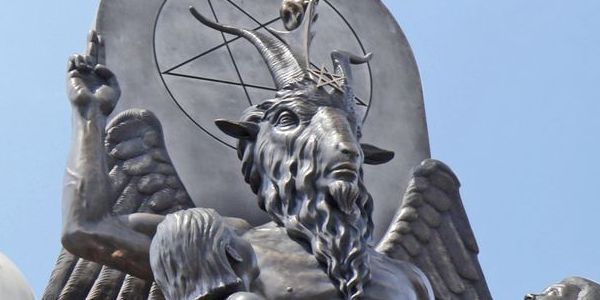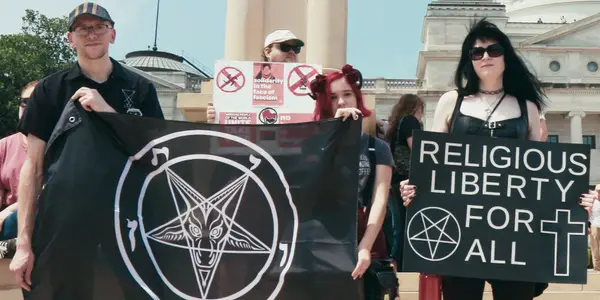HAIL, SATAN?: Solipsistic Liberalism In The Age Of Pence

Andrew Emerson is a University of Chicago student. His high…
Penny Lane’s Hail, Satan? is an expository documentary about The Satanic Temple (henceforth TST), an organization that has made headlines in recent years for holding “satanic masses” and attempting to erect statues of satanic figures near state capitols. As you might imagine, these efforts haven’t exactly endeared TST to members of the Christian community. The Archdiocese of Boston claimed that TST practices “destructive works of evil,” and one Catholic theologian has even compared TST members to practitioners of child sacrifice.
As Lane shows us in Hail, Satan?, however, TST actually isn’t quite what its name makes it out to be. Far from being devil worshippers, TST members see Satan as a symbol for resistance to the status quo, an anti-Christian emblem that dovetails with their firm belief in secular humanism. Because of this, TST’s satanic masses and statues shouldn’t be interpreted literally. Rather, these endeavors are meant to be satirical, drawing attention to “Christian privilege” and the influence of the religious right on public policy in America.
A Lack of Curiosity
On the whole, Hail, Satan? suffers from two major problems. First, it leaves a lot of interesting questions unanswered. Around an hour into the film, for instance, a TST member suggests that TST isn’t a religion: acknowledging that he’s really just an atheist, he notes that he prefers Satanism because “being an atheist is boring.” Mere minutes later, however, another TST member directly contradicts this argument. Citing TST’s “Seven Tenets,” a declaration of principles that’s essentially a secular-humanist manifesto, he asks, “Why can’t me following a code of ethics, having fellowship with brethren – why can’t that be a religion?”

Whether TST counts as a religion merits debate – as does the corollary question of what religion is in the first place – and Lane definitely could’ve explored this topic further. In the actual film, however, she raises this question through the aforementioned juxtaposition of TST members, only to then spend the rest of the film recounting TST’s efforts to remove a Ten Commandments monument outside the Arkansas State Capitol. Since it features a stark antagonism between TST and Jason Rapert, the Arkansas legislator who sponsored said monument, this recounting certainly makes for a riveting watch. But given what immediately precedes it, you can’t help but feel that Lane is ducking out of a challenge, as though she were deliberately opting for shallow entertainment over deeper, more complex inquiry.
The Glorification of Trolls
From here, the bigger problem with Hail, Satan? is the connection it makes between TST and the current political climate. As you quickly come to see, Hail, Satan? doesn’t pretend to be unbiased towards its subject matter. On the contrary: Lane not only admires what TST does, but she goes so far as to imply that TST constitutes a model of resistance in the Trump era, an example that all frustrated liberals could watch and learn lessons from.
To be sure, Lane never explicitly expresses these sentiments. But her approving attitude towards TST – and her disapproving one towards its right-wing opponents – nevertheless manifests itself at several points in the film. For instance, as one TST member discusses the rise of “Christian supremacy,” Lane inserts shots of Mike Pence and Jack Phillips, the plaintiff in a recent Supreme Court case about religious liberty. By including images of people who have never directly interacted with TST, Lane suggests that TST’s impact goes beyond its narrow efforts to erect satanic statues, as though it were actually on the front-lines of a larger, further-reaching battle against evangelical conservatism.

Images of Pence aside, Hail, Satan? exalts TST in several other places as well. For instance, a scene about the Seven Tenets is set to holy, uplifting music, as though Lane wanted to underscore this manifesto’s significance and value. Elsewhere, furthermore, when a TST member notes that the “satanic panic” of the 1980s was fake, Lane cuts, unprompted, to news footage about the Catholic Church’s sex abuse scandals. By voluntarily establishing this contrast between fake scandals about non-Christians and real ones about Christians, Lane essentially endorses TST’s worldview – and, by extension, TST itself.
All in all, then, Hail, Satan? holds TST up as a model. The problem, however, is that it’s hard to square such admiration with what TST is shown doing. In many ways, after all, TST members are what Milo Yiannopoulos would look like if he were actually a raging liberal. Rather than advocate legislation or directly engage with members of the Christian right, TST members behave like trolls. On the basis of extreme religious caricatures – Lane’s interviewees invariably mention Christianity in the same breath as ignorance, bigotry, or pedophilia – TST members knowingly offend Christians with the disputes they provoke, thereby undercutting their ostensible mission of persuading people of the merits of church-state separation.
Let me put my point somewhat differently. Hail, Satan? advances a worldview in which evangelical conservatives have taken over the levers of power in American politics. But rather than see this as a call for engagement with the other side – evangelical conservatives wouldn’t be in power, after all, if millions of ordinary Americans didn’t find evangelical conservatism convincing on some level – Lane suggests that dissatisfied liberals would be better off emulating TST’s alienating, caricature-based form of protest.

If, like Lane and the members of TST, you’re a secular humanist, it’s comforting to assume that religious people are invariably stupid or prejudiced. And since it simplifies the nature of your opponents, that idea certainly makes it easier to advocate for church-state separation. But ultimately, these kinds of broad assumptions are just an indirect, narcissistic way of engaging in self-affirmation, the equivalent of thumping your chest and exclaiming, “I’m smart, and everyone else around me is stupid!” In the end, it’s quite hard to like a film that applauds such solipsism as a means of “resistance.”
Hail, Satan? Conclusion
In closing, I should make clear that I’m not writing this review as a religious person. Like TST, I believe in the separation of church and state, and I too, disagree with the views of politicians like Pence. Yet Hail, Satan? simply doesn’t do a good job of making the case for political secularism. Throughout the film, Lane’s treatment of religion is not only superficial, but it’s also wrong-headed, elevating TST’s brand of trolling and demonization at the expense of thoughtful persuasion and debate.
In this sense, Hail, Satan? neatly fits in with a series of recent documentaries – RBG, the soon-to-be-released Ask Dr. Ruth, and others – that do little more than preach to the liberal choir.
Do you agree with me? Why or why not? Please share your thoughts in the comments!
Hail, Satan? was released in the United States on April 19, 2019 and will be released in the UK on July 26, 2019. For all international release dates, see here.
Does content like this matter to you?
Become a Member and support film journalism. Unlock access to all of Film Inquiry`s great articles. Join a community of like-minded readers who are passionate about cinema - get access to our private members Network, give back to independent filmmakers, and more.
Andrew Emerson is a University of Chicago student. His high school English teacher once asked him to read a batch of Roger Ebert’s reviews for class, and he’s been fixated on the idea of writing about movies ever since. You can follow his attempts to pursue this obsession at http://filmwatcher.net/.













